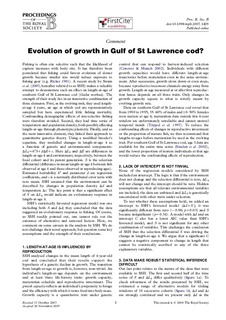| dc.contributor.author | Heino, Mikko | |
| dc.contributor.author | Baulier, Loïc | |
| dc.contributor.author | Boukal, David S. | |
| dc.contributor.author | Dunlop, Erin S. | |
| dc.contributor.author | Eliassen, Sigrunn | |
| dc.contributor.author | Enberg, Katja | |
| dc.contributor.author | Jørgensen, Christian | |
| dc.contributor.author | Varpe, Øystein | |
| dc.date.accessioned | 2010-10-27T09:50:17Z | |
| dc.date.available | 2010-10-27T09:50:17Z | |
| dc.date.issued | 2008-06-22 | |
| dc.identifier.issn | 0080-455X | |
| dc.identifier.issn | 1471-2954 | |
| dc.identifier.uri | http://hdl.handle.net/11250/108356 | |
| dc.description | This is an open-access article distributed under the terms of the Creative Commons Attribution License, which permits unrestricted use, distribution, and reproduction in any medium, provided the original work is properly cited. | en_US |
| dc.description.abstract | Fishing is often size selective such that the likelihood of capture increases with body size. It has therefore been postulated that fishing could favour evolution of slower growth because smaller size would reduce exposure to fishing gear (e.g. Ricker 1981). A recent study by Swain et al. (2007; hereafter referred to as SSH) makes a valuable attempt to demonstrate such an effect on length-at-age of southern Gulf of St Lawrence cod (Gadus morhua). The strength of their study lies in an innovative combination of three elements. First, as the evolving trait, they used length-at-age 4 years, an age at which cod are representatively sampled but have experienced little fishing mortality. Confounding demographic effects of size-selective fishing were therefore avoided. Second, they had time series of temperature and population density, both possibly affecting length-at-age through phenotypic plasticity. Finally, and as the most innovative element, they linked their approach to quantitative genetics theory. Using a modified breeder's equation, they modelled changes in length-at-age 4 as a function of genetic and environmental components: ΔL4=h2S+βΔE+ϵ. Here ΔL4 and ΔE are differences in length-at-age 4 and environment, respectively, between the focal cohort and its parent generation. S is the selection differential (difference in mean length-at-age 4 between fish observed at age 4 and those observed at reproducing ages). Estimated heritability h2 and parameter β are regression coefficients, and ϵ is a normally distributed error term with zero mean. SSH assumed that the environment can be described by changes in population density Δd and temperature Δt. The key point is that a significant effect of S on ΔL4 would indicate an evolutionary response in length-at-age 4.
SSH's statistically favoured regression model was one including both S and Δd; they concluded that the data suggested an evolutionary response to fishing. Of course, as SSH readily pointed out, one cannot rule out the existence of alternative and untested factors. Here, we comment on some caveats in the analysis by SSH. We do not challenge their novel approach, but question some key assumptions and the strength of their conclusions. | en_US |
| dc.language.iso | eng | en_US |
| dc.publisher | Royal Society Publishing | en_US |
| dc.subject | population dynamics | en_US |
| dc.subject | populasjonsdynamikk | en_US |
| dc.title | Evolution of growth in Gulf of St Lawrence cod? | en_US |
| dc.type | Journal article | en_US |
| dc.type | Peer reviewed | |
| dc.subject.nsi | VDP::Agriculture and fishery disciplines: 900::Fisheries science: 920::Resource biology: 921 | en_US |
| dc.source.pagenumber | 1111-1112 | en_US |
| dc.source.volume | 275 | |
| dc.source.journal | Proceedings of the Royal Society B: Biological Sciences | |
| dc.source.issue | 1639 | |
| dc.identifier.doi | http://dx.doi.org/10.1098/rspb.2007.1429 | |
